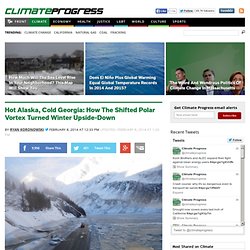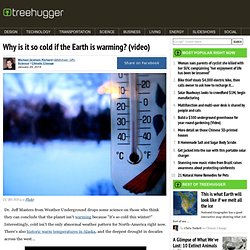

Is El Niño Developing? Data from ocean-observing satellites and other ocean sensors indicate that El Niño conditions appear to be developing in the equatorial Pacific Ocean.

Conditions in May 2014 bear some similarities to those of May 1997, a year that brought one of the most potent El Niño events of the 20th century. During an El Niño, easterly trade winds in the Pacific falter and allow giant waves of warm water—known as Kelvin waves—to drift across from the western Pacific toward South America. Surface waters in the central and eastern Pacific become significantly warmer than normal, altering weather patterns and affecting fisheries along the west coasts of the Americas. El Niño also can have a significant influence on weather and climate far from the tropics. Scientists debunk climate change myths. Wits University scientists have debunked two big myths around climate change by proving firstly, that despite predictions, tropical storms are not increasing in number.

However, they are shifting, and South Africa could be at increased risk of being directly impacted by tropical cyclones within the next 40 years. Secondly, while global warming is causing frost to be less severe, late season frost is not receding as quickly as flowering is advancing, resulting in increased frost risk which will likely begin to threaten food security. According to Jennifer Fitchett, a PhD student in the Wits School of Geography, Archaeology and Environmental Studies (GAES), there has been an assumption that increasing sea surface temperatures caused by global warming is causing an increase in the number of tropical cyclones.
Aerosols. Carbon Monoxide. Global Maps. Greenland glacier hits record speeds. Economist Says Best Climate Fix A Tough Sell, But Worth It. We often talk about climate change as a matter of science.

But the biggest questions are really about money. How much would it cost to fix the problem — and what price will we pay if we don't? The man who invented the field of climate economics 40 years ago says there's actually a straightforward way to solve the problem. Warming Arctic May Be Causing Jet Stream To Lose Its Way : The Two-Way. Hide captionThe jet stream that circles Earth's north pole travels west to east.

But when the jet stream interacts with a Rossby wave, as shown here, the winds can wander far north and south, bringing frigid air to normally mild southern states. The jet stream that circles Earth's north pole travels west to east. But when the jet stream interacts with a Rossby wave, as shown here, the winds can wander far north and south, bringing frigid air to normally mild southern states. Trees On The Move As Temperature Zones Shift 3.8 Feet A Day : Krulwich Wonders... Yaleclimateforum. Six Things We Learned About Our Changing Climate in 2013.
Global Winds in Real Time. Weather Extremes : Heavy Rain Makes Dent in California Drought. Japan Breaks National Heat Record. Chinese Heat Wave Continues An all-time national heat record was set in Japan today (August 12th) when the temperature peaked at 41.0°C (105.8°F) at the Ekawasaki site in Shimanto (part of Kochi Prefecture).
The previous record of 40.9°C (105.6°F) was recorded at Tajima and Kumagaya on August 16, 2007. Snowpackcomparison.jpg (JPEG Image, 700 × 393 pixels) Global Analysis - Annual 2013. Maps and Time Series Temperature and Precipitation Maps Annual Temperature Anomalies Time Series Annual Contents of this Section: Global Highlights The year 2013 ties with 2003 as the fourth warmest year globally since records began in 1880. Global Temperatures. How the U.S. Exports Global Warming. Winter Haze over Bangladesh. Energy, the Environment, and Our Future. California's Recent Droughts Have Grown Longer And Stronger.
By Joe Romm "California’s Recent Droughts Have Grown Longer And Stronger" The good news: Parts of California are finally getting some much needed precipitation.

Hot Alaska, Cold Georgia: How The Shifted Polar Vortex Turned Winter Upside-Down. By Ryan Koronowski "Hot Alaska, Cold Georgia: How The Shifted Polar Vortex Turned Winter Upside-Down" A photo released Wednesday Jan. 29, 2014, by the Alaska Department of Transportation & Public Facilities and made on Jan. 25, 2014, shows road crews beginning the job of clearing the closed Richardson Highway, near Valdez, Alaska.

CREDIT: AP Photo/Alaska DOT&PF It’s easy to forget about other places in the world, or even in your own country, when you’re out shoveling snow, or people who are homeless suffer the worst of urban cold snaps, or harbor seals on the Hudson River ride ice floes, or your city shuts down due to a mismanaged winter storm. The polar vortex, normally tucked away much closer to the Arctic, has swept down several times this winter, bringing cold temperatures and snow to large segments of the U.S. east of the Rockies.
Climate Change. Connecting scientists, journalists, and communicators. Yaleclimateforum. Why is it so cold if the Earth is warming? (video) Dr.

Jeff Masters from Weather Underground drops some science on those who think they can conclude that the planet isn't warming because "it's so cold this winter! " Rising Seas - Interactive: If All The Ice Melted.